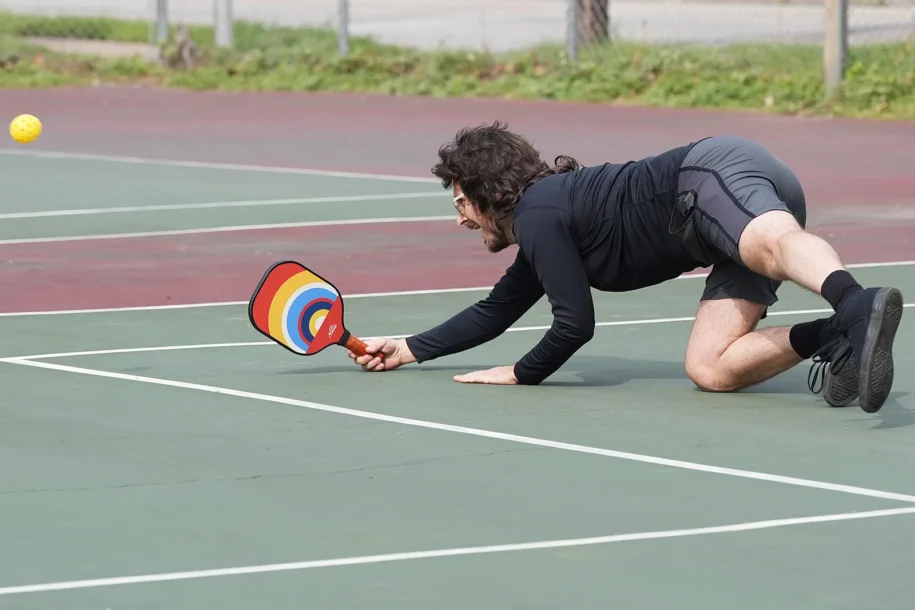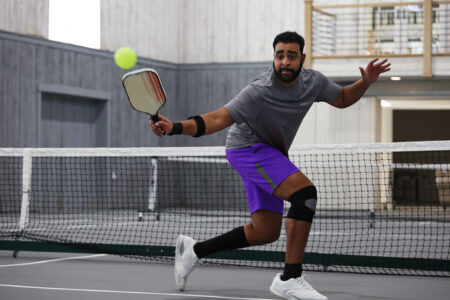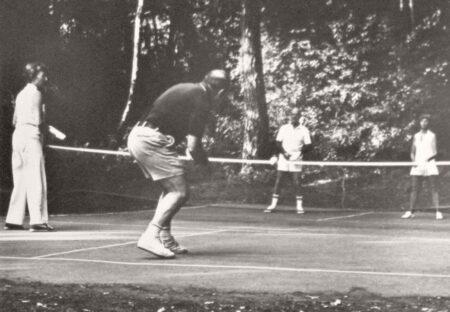
Are you an avid pickleball player? If so, you need to be aware of the common pickleball injuries that can occur while playing this popular sport.
In this article, we will discuss ‘Common Pickleball Injuries: What You Need to Know’ and provide you with valuable information on how to prevent these injuries and what to do if you experience one.
Pickleball is a fast-paced and thrilling game, but it can also be physically demanding. From sprained ankles to shoulder strains, we will cover all the injuries that you may encounter on the pickleball court.
By understanding the risks and taking preventative measures, you can continue enjoying this exciting sport without worrying about getting hurt.
Common Pickleball Injuries
Common pickleball injuries include shoulder strain, knee sprains and muscle strains, meniscal injuries, calf strains and tears, and flares of knee arthritis. These injuries can be caused by repetitive overhead motions, sudden stops and starts, and the fast-paced nature of the game.
Shoulder strain accounts for approximately 20% of all pickleball injuries, while knee sprains and muscle strains make up around 15%. Meniscal injuries, calf strains and tears, and flares of knee arthritis are also prevalent.
These statistics highlight the importance of proper warm-up, conditioning, and injury prevention techniques in pickleball.
Shoulder Strain
When playing pickleball, shoulder strain can occur due to repetitive overhead motions and improper technique. This type of injury is common and can cause pain and discomfort. To prevent shoulder strain, it is important to warm up before playing and use proper technique when hitting the ball overhead.
Here are three tips to help prevent shoulder strain while playing pickleball:
- Strengthen your shoulder muscles through targeted exercises such as shoulder presses and lateral raises.
- Practice proper form and technique, keeping your shoulder relaxed and using your entire body to generate power.
- Take breaks and rest your shoulder if you start to feel any pain or discomfort.
By following these tips, you can reduce the risk of shoulder strain and continue to enjoy playing pickleball without the worry of common injuries.
Knee Sprains and Muscle Strains
To avoid knee sprains and muscle strains, it’s important to warm up properly and use correct technique while playing pickleball. These are some of the most common pickleball injuries, and they can be painful and debilitating.
Knee sprains occur when the ligaments in the knee are stretched or torn, often from sudden movements or twisting. Muscle strains happen when the muscles are overstretched or torn, usually from overexertion or improper form.
To prevent these injuries, make sure to do knee exercises to strengthen the muscles around the knee and improve stability. Additionally, always warm up before playing and use proper technique, such as bending your knees and using your legs to generate power.
By taking these precautions, you can reduce the risk of knee sprains and muscle strains and enjoy a safer pickleball experience.
Meniscal Injuries
Protect your knees and play with confidence by learning about meniscal injuries in pickleball. Meniscal injuries are one of the most common pickleball knee injuries. According to pickleball injury statistics, these injuries occur when the meniscus, a piece of cartilage in the knee joint, gets torn or damaged.
The meniscus helps cushion the knee and absorb shock during movement, so any injury to it can be quite painful. The dangers of pickleball for your knees can increase if you don’t take proper precautions. Landing awkwardly, sudden stops and starts, or pivoting incorrectly can all contribute to meniscal injuries.
It’s important to warm up before playing and to use proper technique to minimize the risk of injury.
Calf Strains and Tears
Calf strains and tears can cause excruciating pain and limit your mobility during pickleball matches. These injuries are common among pickleball players, especially seniors, due to the fast-paced nature of the game.
The repetitive jumping, pivoting, and quick movements put a lot of strain on the calf muscles and can lead to tears or strains. It is important to take proper precautions and incorporate exercises to prevent these injuries.
Stretching and strengthening exercises for the calf muscles, as well as the Achilles tendon, can help reduce the risk of strains and tears. Additionally, knee exercises for pickleball can also be beneficial, as strong knees provide stability and support to the lower leg muscles.
By incorporating these exercises into your routine, you can minimize the chances of experiencing calf strains and tears during pickleball matches.
Flares of Knee Arthritis
Flares of knee arthritis can be dangerous and hinder your ability to play pickleball. The constant movement and quick turns on the court can put strain on your knees, leading to painful flares of knee arthritis. But don’t worry, there are ways to prevent these injuries. Physical therapy can help strengthen the muscles around your knees and provide exercises to reduce the risk of flares. So, don’t let knee arthritis stop you from enjoying the game.
Herniated disks in the lower back
Herniated disks in the lower back can cause excruciating pain and limit your mobility, making it difficult to enjoy activities like pickleball. These injuries occur when the soft inner core of a spinal disk protrudes through the tough outer layer and puts pressure on nearby nerves. The repetitive twisting, bending, and quick movements involved in pickleball can increase the risk of herniated disks in the lower back.
To help prevent these injuries, it’s important to maintain proper form and technique while playing. Strengthening the core muscles can also provide support and stability to the spine. If you do experience a herniated disk, physical therapy can be an effective treatment option. It focuses on relieving pain, improving flexibility, and strengthening the surrounding muscles to support the spine.
Wrist and Lower Leg Injuries
If you thought herniated disks in the lower back were the only common pickleball injuries, think again. Wrist and lower leg injuries are also prevalent in this fast-paced sport.
As pickleball injuries are on the rise, it is important to understand the most common ones and how physical therapy can help in recovery.
Wrist injuries, such as sprains and strains, can occur due to the repetitive motions involved in pickleball. Likewise, lower leg injuries, like ankle sprains and calf strains, can result from sudden stops and pivots on the court.
To prevent these injuries, make sure to warm up before playing, wear supportive shoes, and use proper technique when hitting the ball.
Head, Lower Trunk, Ankle, Knee, and Shoulder Injuries
Protect yourself from potential injuries during pickleball by being aware of the common areas of the body that are susceptible to harm. These areas include the head, lower trunk, ankle, knee, and shoulder.
Head injuries can occur from getting hit by a fast-moving ball or colliding with another player. Lower trunk injuries, such as back strains and muscle pulls, can happen due to the twisting and turning movements involved in the game.
Ankles and knees are prone to sprains and strains from sudden stops, starts, and changes in direction. Shoulder injuries can result from repetitive overhead swings.
To prevent these injuries, it is important to warm up properly before playing, wear protective gear like helmets and knee pads, use proper technique and form, and listen to your body’s signals to avoid overexertion.
How to Prevent Pickleball Injuries
To prevent pickleball injuries, make sure you start your game with a proper warm-up and stretching routine. This will help loosen your muscles and increase blood flow to prevent strains and sprains. Engaging in exercises to improve balance and stamina is also important. This can include activities like yoga or Pilates, which help strengthen your core and improve your overall stability on the court.
Wearing appropriate footwear and protective gear is crucial in preventing injuries. Make sure you have proper court shoes with good traction to prevent slips and falls. Additionally, wearing knee pads and elbow pads can provide extra protection for vulnerable joints.
Using proper technique and form when playing is another key factor in injury prevention. This means using the correct grip, stance, and swing mechanics to minimize strain on your body. Taking breaks and resting when necessary is also important. Pushing through fatigue can lead to poor form and increased risk of injury, so listen to your body and take breaks when needed.
To help you visualize the information, here is a table summarizing the ways to prevent pickleball injuries:
| Ways to Prevent Pickleball Injuries |
|---|
| Proper warm-up and stretching |
| Engaging in exercises for balance and stamina |
| Wearing appropriate footwear and protective gear |
| Using proper technique and form |
| Taking breaks and resting when necessary |
By following these guidelines, you can greatly reduce your risk of pickleball injuries. However, accidents can still happen.
What to Do if You Experience a Pickleball Injury
Now that you know how to prevent pickleball injuries, it’s important to be prepared in case you do experience one. Accidents can happen, even with the best precautions in place. If you find yourself injured while playing pickleball, it is crucial to seek medical attention as soon as possible.
Seeking medical attention for a pickleball injury is important because it allows trained professionals to properly assess the extent of your injury and provide appropriate treatment. They can determine if any bones are fractured, if there are any torn ligaments or tendons, or if there are any other underlying issues that need to be addressed. Ignoring an injury or attempting to self-diagnose can lead to further complications and delay the healing process.
In addition to seeking medical attention, it is also important to follow the RICE technique for treating injuries: Rest, Ice, Compression, and Elevation. This technique is widely recommended for acute injuries and can help reduce pain, swelling, and inflammation. Here’s how you can apply the RICE technique:
- Rest: Avoid putting weight or strain on the injured area to allow it to heal.
- Ice: Apply an ice pack or cold compress to the injured area for 15-20 minutes every 2-3 hours to reduce swelling.
- Compression: Use a compression bandage or wrap to apply gentle pressure to the injured area, which can help reduce swelling.
- Elevation: Raise the injured area above the level of your heart to help reduce swelling and promote healing.
Conclusion
In conclusion, pickleball is a fun and exciting sport, but it’s important to be aware of the potential injuries that can occur. By taking preventative measures, such as warming up properly and using the correct equipment, you can greatly reduce your risk of getting hurt. However, accidents can still happen, so it’s crucial to know what to do if you do experience a pickleball injury. Remember to listen to your body, seek medical attention if necessary, and take the time to properly recover so you can get back on the court as soon as possible.
Frequently Asked Questions
What are the benefits of playing pickleball?
Playing pickleball offers numerous benefits. It’s a fun and social activity that helps improve your cardiovascular health, coordination, and balance. Plus, it’s a low-impact sport that reduces the risk of joint injuries.
Can children play pickleball or is it more suitable for adults?
Children can play pickleball, as it is suitable for all ages. The game’s smaller court size and slower pace make it accessible and enjoyable for kids. It’s a great way for them to stay active and have fun.
Are there any specific warm-up exercises recommended before playing pickleball?
Before playing pickleball, it’s important to warm up to prevent injuries. Try exercises like arm circles, lunges, and shoulder stretches to prepare your body. Remember to start slow and gradually increase intensity.
How long does it typically take to recover from a pickleball injury?
Recovery time for a pickleball injury varies depending on the type and severity of the injury. It can take anywhere from a few days to several weeks or even months to fully recover.
Are there any specific dietary recommendations to support injury prevention in pickleball?
To support injury prevention in pickleball, it’s important to maintain a balanced diet. Focus on consuming nutrient-dense foods like fruits, vegetables, lean proteins, and whole grains. Stay hydrated and avoid excessive consumption of sugary and processed foods.





